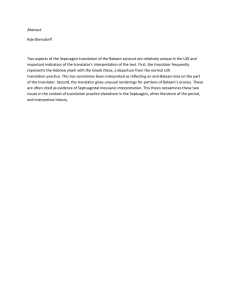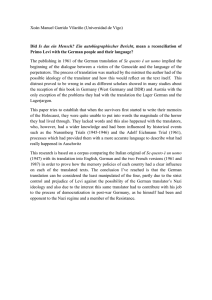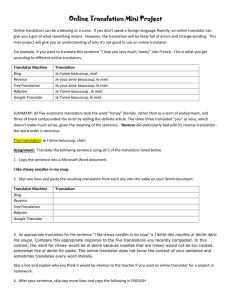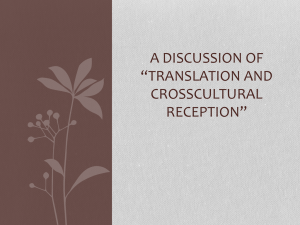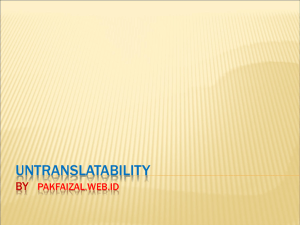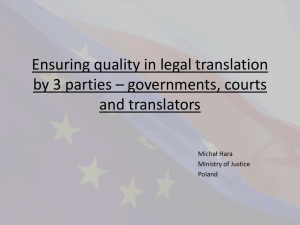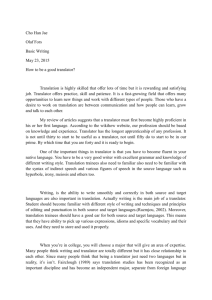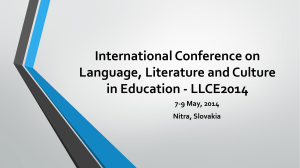The role of the translator: visibility, ethics and sociology Chapter 9
advertisement
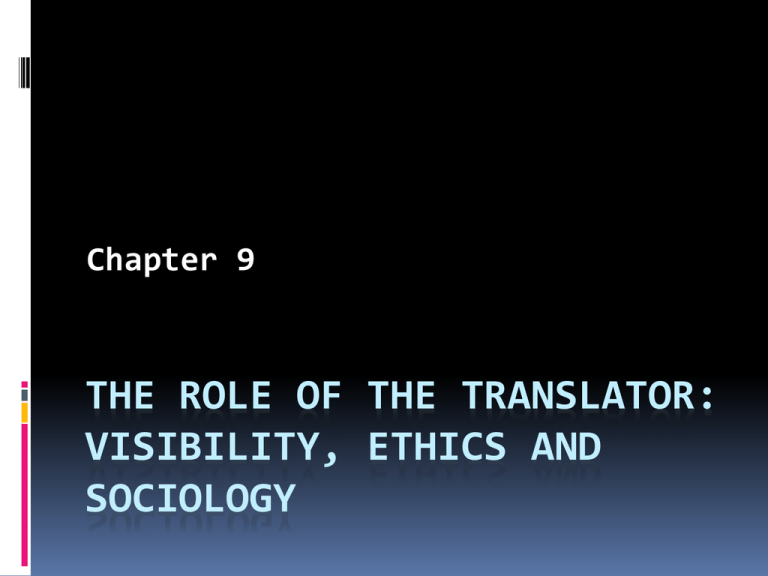
Chapter 9 THE ROLE OF THE TRANSLATOR: VISIBILITY, ETHICS AND SOCIOLOGY The cultural and political agenda of translation Venuti and the ‘invisibility’ of the translator Invisibility is used ‘to describe the translator’s situation and activity in contemporary AngloAmerican culture’. Invisibility is produced by: 1- the way translators themselves tend to translate ‘fluently’ into English creating an ‘illusion of transparency’. 2- the way the translated texts are read in the target culture. Domestication and foreignization Two types of translating strategy • Domestication entails translating in a transparent, fluent. ‘invisible’ style in order to minimize the foreignness of the TT. (leaves the reader in peace) • Foreignization entails choosing a foreign text and developing a translation method along lines which are excluded by dominant cultural values in the TL. (leaves the writer in peace) In his book The Scandals of Translation, Venuti continues to insist on foreignizing translation, to cultivate a varied and ‘heterogeneous discourse’. Although he advocates foreignizing translation, he is also aware of its contradictions. Antonio Berman: the ‘negative analytic’ of translation • Berman deplores the general tendency to negate the foreign in translation by the translation strategy of ‘naturalization’. • He considers that there is generally a ‘system of textual deformation’ in TTs that prevents the foreign coming through. • He identifies 12 deforming tendencies: 1. Rationalization. 2. Clarification. 3. Expansion. 4. Ennoblement. 5. Qualitative impoverishment. 6. Quantitative impoverishment. 7. The destruction of rhythms. 8. The destruction of underlying network of signification. 9. The destruction of linguistic patternings. 10. The destruction of vernacular networks or their exoticization. 11. The destruction of expressions and idioms. 12. The effacement of the superimposition of languages. The position and positionality of the literary translator The translators often consider that their work is intuitive and that they must listen to their ‘ear’ Felstiner makes the important point that much of the work that goes into producing a translation ‘becomes invisible once the new poem stands intact’. Levine sees herself as a ‘translator-collaborator’ and as a ‘subversive scribe, ‘destroying’ the form of the original but reproducing the meaning in a new form. Maria Tymoczko takes issue with those who see the translator as a neutral mediator in the act of translation. Some translators have shown themselves to be more vociferous about the injustice of the publishing process. The power network of the publishing industry Publishers, as Venuti shows, are very reluctant to grant copyright or a share of the royalties to the translator . Fawcett describes this complex network as amounting to a ‘power play’, with the final product considerably shaped by editors and copy-editors. In some cases, the power play may result in the ST author being omitted from the translation process altogether. Another key player in the process is the author’s literary agent. Discussion of Venuti’s work Pym takes issue with Venuti’s figures Venuti’s general premises about foreignizing and domesticating translation strategies, and about the invisibility of translator and the relative power of the publisher and the translator can be investigated in a variety of ways. P (154) The reception and reviewing of translations Most English reviews prefer ‘fluent’ translations. Paratextual elements: - Peritexts- in the same location - Epitexts- not materially appended to the text Reviews are either: Synchronic- all at the same time Diachronic- over a longer time period The sociology and historiography of translation What exactly causes a translator to act in a given way in a given situation? Why does one translator act differently from an other? (Munday, 2008) Chesterman’s paper- translation practice

